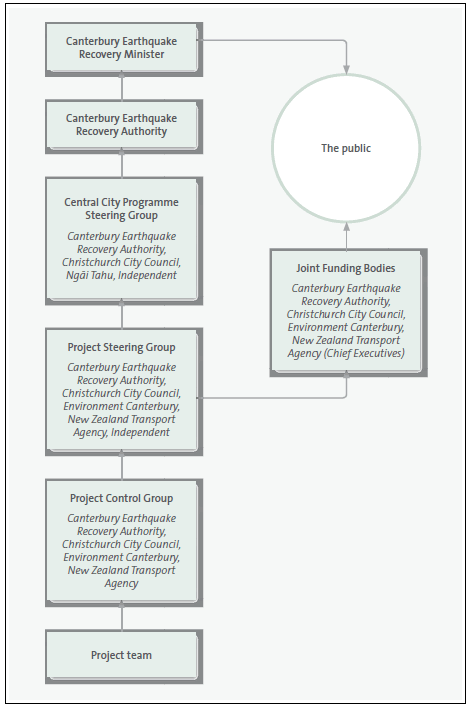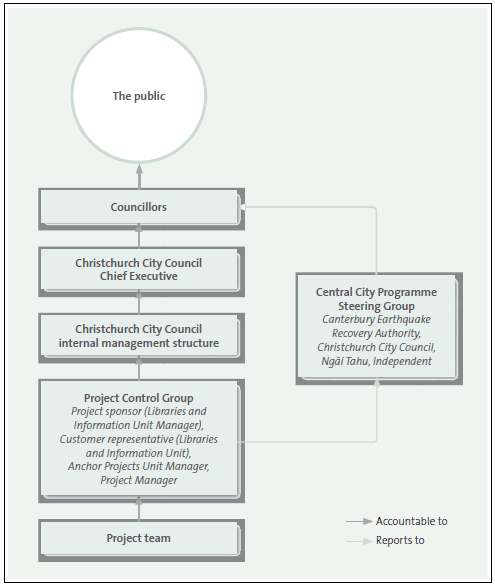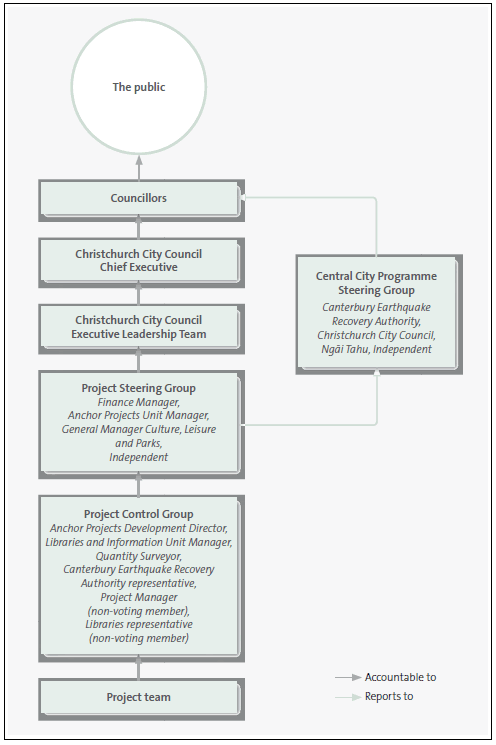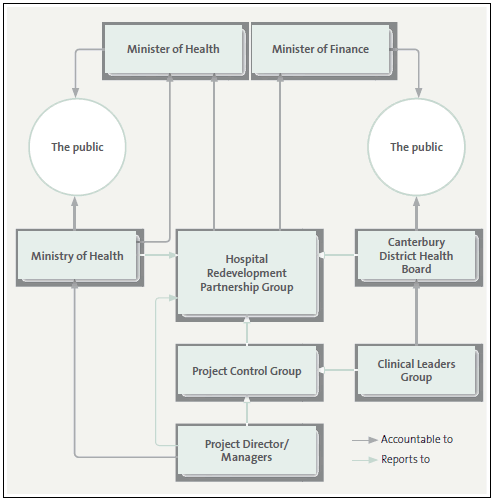Part 2: The Christchurch rebuild and the three projects we looked at
2.1
In this Part, we discuss the context for the Christchurch rebuild and the three projects that we looked at. In particular, we:
- explain the background to the rebuild and the main entities involved; and
- describe the three projects, including their governance arrangements, and why we chose to look at them.
The Christchurch rebuild
2.2
Since the major earthquakes in Canterbury in 2010 and 2011, local government, central government, the private sector, and the community have been working together to help Canterbury recover. The earthquakes destroyed much of central Christchurch, and a large part of the recovery effort is focused on the central city.
2.3
In May 2012, CERA published its Recovery Strategy for Greater Christchurch. This was followed in July 2012 by the Christchurch Central Recovery Plan, released jointly by the Government, the Council, and Ngāi Tahu. The Christchurch Central Recovery Plan included a blueprint for the central city that identified 17 anchor projects to inspire confidence in the recovery and stimulate further development.
2.4
CERA is responsible for the overall recovery strategy and for leading the rebuild of the central city. CERA is also the lead agency for constructing some, but not all, of the anchor projects.
2.5
In June 2013, the Cost Sharing Agreement between the Crown and Christchurch City Council was signed. The Agreement sets out how costs and responsibilities will be shared to deliver the Christchurch Central Recovery Plan and the city's horizontal infrastructure rebuild.
2.6
The recovery has long-term implications for people's lives as well as the economy. Rebuilding Canterbury is a priority for the Government and involves significant public spending. Strong governance is needed to ensure that public funds are being spent appropriately, to ensure that entities work together to deliver intended outcomes, and to provide clear accountability for Cantabrians and all New Zealanders.
The projects we looked at
Bus Interchange
2.7
CERA led the project to build a new Bus Interchange to replace the old interchange, which the earthquakes had damaged. The project had a budget of $53 million, with costs shared between CERA, the New Zealand Transport Agency (NZTA), and the Council. Environment Canterbury (ECan) is also a major stakeholder because it is responsible for bus services.
2.8
The Bus Interchange is on a 14,000m2 site south of the Retail Precinct and next to the Justice and Emergency Services Precinct. The Bus Interchange is expected to cater for up to 18,000 passengers a day to start with, increasing to 70,000 by 2041.
2.9
The Bus Interchange has important links to other projects and programmes of work – in particular, An Accessible City and the Justice and Emergency Services Precinct.
2.10
An Accessible City will create a transport network that makes moving around Christchurch easy, safe, and enjoyable. It includes future road layouts that provide for:
- pedestrians, cyclists, public transport, and private vehicles;
- speed zones and streetscapes;
- parking; and
- service vehicle requirements.
2.11
The Justice and Emergency Services Precinct is located next to the Bus Interchange. During construction, a temporary bus interchange was located on the Justice and Emergency Services Precinct site. The temporary interchange needed to vacate the site by the end of May 2015 so that construction on the Justice and Emergency Services Precinct could start. This was an important constraint for the Bus Interchange project because any delay in leaving the Justice and Emergency Services Precinct would have led to financial penalties.
2.12
The Bus Interchange comprises 16 bus bays and passenger lounges with retail areas and bike storage facilities. Passengers board buses through glass doors. Screens provide information about bus arrivals and departures, and direct passengers to the right bay for their bus. The interchange has several retail and information kiosks.
2.13
On 25 May 2015, the first part of the Bus Interchange, including some of the passenger areas and eight bus bays, opened. This met the time constraint for vacating the Justice and Emergency Services Precinct site. The rest of the Bus Interchange opened on 20 August. It was the first government-led anchor project to be completed.
2.14
A Project Steering Group was responsible for "overall project leadership" and provided governance. The Project Steering Group had members from all the main stakeholders: CERA, the Council, NZTA, and ECan. In October 2014, an independent chairperson was appointed.
2.15
The Project Steering Group reported to the Central City Programme Steering Group, which provided governance at a programme level, such as prioritising and aligning projects and programme-level risks and matters. A Project Control Group supported the Project Steering Group and also included members from all stakeholders.
2.16
Figure 2 shows the governance structure for the Bus Interchange project.
Figure 2
Bus Interchange project governance structure

Sources: CERA and the Office of the Auditor-General.
New Central Library
2.17
The Council is leading the project to build a new Central Library. On 26 March 2015, councillors approved the project's business case and concept design. The project is now in the tender phase. The New Central Library project has a budget of $85 million, including $75 million from the Council and $10 million of philanthropic funding.
2.18
The library will be a five-storey building with a gross floor area of just under 10,000m2. It will be on a 2725m2 site on the north-east corner of Cathedral Square, next to the Performing Arts and Convention Centre Precincts. The library is expected to open in mid-2018.
2.19
The earthquakes damaged the old central library in Gloucester Street. That building has been demolished, and the site will be part of a new convention centre. Until the new library is built, the library is housed in two temporary facilities in Manchester Street and Peterborough Street.
2.20
The Council found out what people wanted from the new library through its Your library, your voice campaign, which received more than 2400 responses. The project recognises that a modern library is not just a place where people borrow books. It is also a hub where people can "discover, connect and play". The Council also hopes that the new Central Library will act as a catalyst for regeneration by bringing people back into the central city.
2.21
Figure 3 shows our interpretation of the governance and management structure for the project when we carried out our audit in December 2014. In the documents we reviewed, we found no diagram of the structure that accurately reflected the arrangements on the ground. Our interpretation is based on information that we gathered from interviews and document reviews.
2.22
At the time of our audit in December 2014, the Council identified the Project Control Group as the main group providing governance to the New Central Library project. Therefore, we focused on this group at that time.
2.23
The elected councillors provide the highest level of governance for the project. They have the authority to make decisions that will determine the type of library that will be built and how much they spend on it. The New Central Library project also reports to the Central City Programme Steering Group.
Figure 3
New Central Library project governance structure, December 2014

Source: Office of the Auditor-General
2.24
After we completed our audit work in December 2014, the Council redesigned the governance structure for this project. A new Project Steering Group now provides governance, while the Project Control Group acts at a management level. The Project Steering Group includes an independent chairperson.
2.25
Figure 4 shows the new governance arrangements.
Figure 4
New Central Library project governance structure, October 2015

Source: Office of the Auditor-General.
Christchurch Hospital Acute Services Building
2.26
The Acute Services Building is a new building on the Christchurch Hospital campus. It is part of the Canterbury District Health Board Facilities Development Project, a $650 million programme of work that includes redevelopment at Burwood Hospital.
2.27
The Acute Services Building will have:
- new operating theatres;
- about 400 beds;
- an expanded intensive care unit;
- a state-of-the-art radiology department;
- a new emergency department; and
- a rooftop helipad.
2.28
The work at Burwood Hospital is being done before the Acute Services Building and is expected to be completed in 2016. The Acute Services Building is due to be completed in March 2018.
2.29
Strictly speaking, the Acute Services Building project is not part of the earthquake recovery. However, it is being completed during a time of significant rebuild in Christchurch and will face the same environment and constraints as other projects, such as a shortage of subcontractors.
2.30
Canterbury District Health Board (the DHB) had already produced a business case for its facilities development before the Canterbury earthquakes. The earthquakes significantly damaged the DHB's facilities. Many of its remaining hospital beds were at risk of damage from further earthquakes. There was also a risk that engineering reports could find them unsafe and they would need to be vacated. This increased the urgency of building new facilities.
2.31
We decided to look at the Acute Services Building project because of its size and its strategic importance to the rebuild and to the people of Christchurch and the Canterbury region.
New arrangements
2.32
Usually, district health boards manage their own major construction projects and put their own governance arrangements in place. The Ministry monitors the project and advises Cabinet on any important decisions.
2.33
With this project, the Government said it was concerned that the DHB was under a lot of pressure providing day-to-day health services as well as managing its own recovery from the earthquakes. Therefore, the Government decided to introduce new governance and management arrangements for the DHB's facilities development to relieve the pressure on the DHB and bring in expertise that could help build some of the new facilities quickly.
2.34
Under the new arrangements, the Ministry is responsible for managing the project and holds the legal authority for any contracts. This was a new role for the Ministry, which is using a mix of existing staff and external contractors to manage the project.
2.35
The Minister of Health appointed a new group, the Hospital Redevelopment Partnership Group (the HRPG), to provide governance for the project. The HRPG has four full members. Three, including the chairperson, are independent. Between them, the independent members bring a range of experience of major construction projects and healthcare. The fourth member is the chairperson of the DHB. The HRPG also has members who represent the Ministry, the DHB, and CERA.
2.36
The HRPG also oversees other construction projects, including earthquake repairs, car parking, and a new outpatients facility. These projects are on, or next to, the Christchurch Hospital campus. The new governance arrangements also apply to the work at Burwood Hospital. Our audit focused only on the Acute Services Building.
2.37
The Government has now introduced similar governance and management arrangements for other major construction projects in the health sector, in Dunedin and on the West Coast. The Ministry told us that it expects the new model to become the norm for major health capital projects. Therefore, any lessons that can be learned from this project will have wider implications.
2.38
Figure 5 shows our understanding of the governance structure for the project. Our interpretation is based on information that we gathered from interviews and reviews of documents.
Figure 5
Acute Services Building project governance structure

Source: Office of the Auditor-General
Note: The DHB is generally accountable to the Minister of Health. However, for this project, the DHB's accountabilities are unclear. This is explained further in Part 5.

